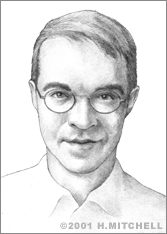Brian Hubert
Brian Hubert says he never goes to sleep without a pen and notebook by his nightstand so that he can record ideas for new inventions. He obviously had the right idea. In March 2001, he had two patents with three pending and was chosen as the 2001 recipient of the $30,000 Lemelson-MIT Student Prize for his invention.
When he was just eight years old, Hubert developed an energy conversion machine that would convert the weight of water into electrical energy while it sat upon the ocean floor. As a child, he also invented the "Cheater Meter," a pocket-sized device that would alert customers if they were being cheated when pumping gasoline at the filling station. He created trash bags that would remain upright in a trash can and cups that allowed one to drink beverages while upside-down as well.
Hubert's early interest in creating innovative solutions for everyday problems carried into his adult life. He earned his bachelor's and master's degrees in mechanical engineering from the Massachusetts Institute of Technology (MIT) and was a superconductor materials scientist at the Los Alamos National Laboratory from 1993 to 1995. Hubert, who also received his PhD at MIT, has a patent on an all-printed plastic memory chip that can be easily and cheaply produced, is mechanically flexible, and stores data when the power is shut off. This technology is useful for smart cards, digital cameras, and portable computational devices that require cheap, high-capacity memory chips.
Hubert also holds a patent on a design for a novel superconductor fabrication system. The ultra-expensive design contains only two moving parts and can run unattended for hundreds of hours. Competing superconductor technologies often require million dollar lasers and complicated vacuum systems to run efficiently.
Much of Hubert's work is in the area of nanotechnology, which focuses on building things at the minute scale of nanometers (a nanometer is one-billionth of a meter). While working on his doctoral thesis, Hubert developed the world's first universal "pick-and-place" nano-assembly machine. The machine is capable of picking up and assembling virtually any type of material, several thousand atoms at a time. It's quite possible that in the future, Hubert's nano-assembly process could profoundly impact the field of genetically-based medicine. The process could be used, for example, for moving, positioning, and patterning segments of DNA strands for the fabrication of ultra-dense gene chips. Such devices could help doctors to discover genetic-related diseases in an individual in minutes, and long before the patient showed any symptoms.
Hubert also created stock analysis software, which pinpoints investment opportunities in the securities markets by simulating nearly every possible combination of buying, selling, shorting, and covering. Additionally, his hip joint replacement implant mimics the bending action of a normal bone, yet it exponentially increases in strength the more it bends. His "Atlas" wallboard installation machine, designed with the help of a team of fellow MIT students, lifts and positions 120-pound sheets of wallboard onto vaulted ceilings and walls up to 15 feet in height. In addition, his audio pre-amplifier was developed to enhance audio signal purity.
Hubert’s inventions appeared in many national news publications. Currently, Hubert is the Executive Vice President of Product and Business Development at MTPV Power Corporation, a clean energy semiconductor chip company.


